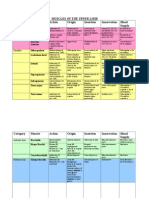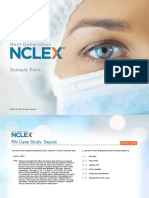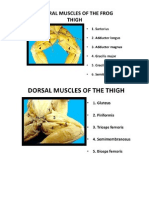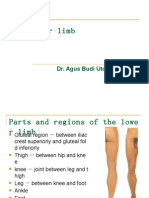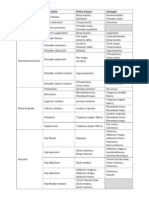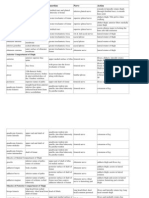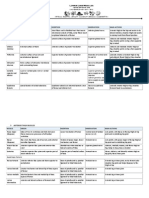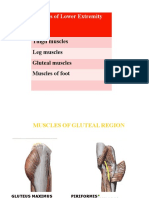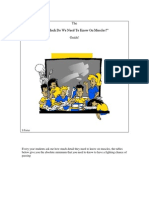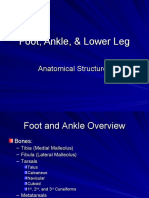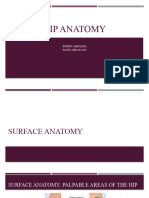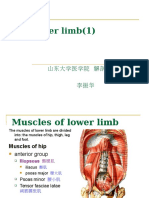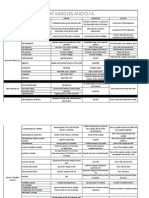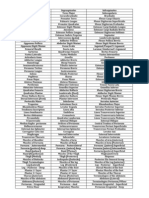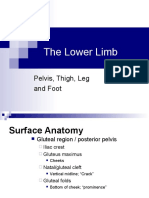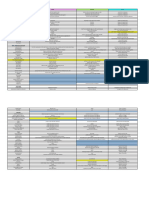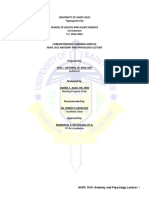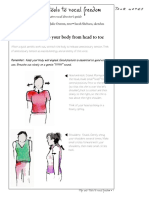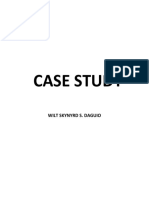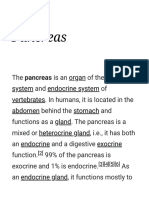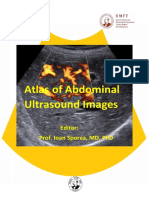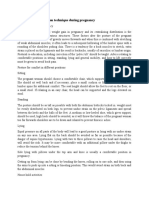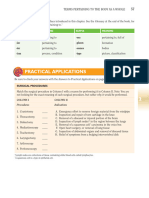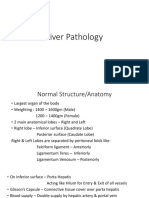Muscle Location Origin Insertion Joint Action Hip Flexors
Muscle Location Origin Insertion Joint Action Hip Flexors
Uploaded by
Mie CorsCopyright:
Available Formats
Muscle Location Origin Insertion Joint Action Hip Flexors
Muscle Location Origin Insertion Joint Action Hip Flexors
Uploaded by
Mie CorsOriginal Description:
Original Title
Copyright
Available Formats
Share this document
Did you find this document useful?
Is this content inappropriate?
Copyright:
Available Formats
Muscle Location Origin Insertion Joint Action Hip Flexors
Muscle Location Origin Insertion Joint Action Hip Flexors
Uploaded by
Mie CorsCopyright:
Available Formats
Muscle
Location
Origin
Insertion
Joint
Action
Hip Flexors
Sartorius
Anterior thigh
Rectis Femorus
(only quad to cross the
hip)
Anterior thigh
Tensor Fascia Latae
Anteriolateral hip
ASIS
AIIS
Posterior ASIS
Pes Anserinus
Tibial turberosity via
the quadrideps tendon
and the patellar
ligament
Gerdys tubercle via
the iliotibial tract
Hip
Flexion
Adduction
Lateral Rotation
Knee
Flexion (weak)
Medial Rotation
Hip
Flexion
Knee
Extension
Hip
Flexion
Media Rotation
Abduction (weak)
Knee
Stabilizes ambulation
Iliacus
Deep pelvic cavity
Iliac fossa
Lesser trochanter
Hip
Flexion
Lateral Rotation
Psoas Major
Deep posterior wall of
abdominal cavity
Bodies of T12, L1-5
Lesser trochanter
Transverse processes of
L1-5
HIP
Flexion (PM)
Psoas Minor
Deep posterior wall of
abdominal cavity
Body of T12
HIP
Posture stabilizer
Superior pubic ramis
Muscle
Location
Origin
Insertion
Joint
Action
Hip Extensors
Gluteus Maximus
(antagonist to Temsor
Facia Latae)
Butt (lateral sacrum,
wing of ilium)
PSIS
Lateral sacrum
Sacrotuberous
Ligament
Superior/Diagonal
iliotibial tract
Hip
Inferior/HJorizontal
gluteal tuberosity of
femur
Biceps Femoris long
head
Posteriolateral thigh
Biceps Femoris short
head
Semitendonosis
Semimembranosis
Ischial tuberosity
Lateral anterior head of
fibula
Distal half of linea
apnea
Posterior thigh
Ischial tuberosity
Pes anserinus
Extension/hyper
extension
Lateral Rotation
Abduction
Adduction
(antagonist to
diagonal fibers
Hip
Extension
Knee
Flexion
Knee
Flexion
Hip
Extension
Knee
Flexion
Deep to semitendonosis Ischial tuberosity
on posterior thigh
Posterior of medial
condyle of tibia
Hip
Extension
Knee
Flexion
Medial Rotation
Gluteus Medius
(most lateral thigh
muscle)
Lateral hip
Posterior ilium,
superior medial
gluteal lines
Greater trochanter
Hip
Abduction (PM)
Flexion
Medial Rotation
Gluteus Minimus
Deep to gluteus medius
Posterior ilium, medial
inferior gluteal lines
Greater trochanter
Hip
Abduction
Flexion
Medial Rotation
Hip Abductors
Muscle
Location
Origin
Insertion
Joint
Action
Deep Six Lateral Rotators
Piriformis
Deep to gluteus
maximus
Anteriolateral sacrum
Anterior Greater
trochanter
Hip
Lateral rotation
Abduction
(antagonist to
quadratis femoris)
Gemellus Superior
Just inferior to
Piriformis
Ischial spine
Greater trochanter
Hip
Lateral rotation
Obturator Internus
Just inferior to
Gemellus Superior
Obturator foremen
Greater trochanter
Hip
Lateral rotation
Gemellus Inferior
Just inferior to
Obturator Internus
Just inferior to ischial
spine
Greater trochanter
Hip
Lateral rotation
Obturator Externis
Anterior to Gemellus
Inferior
Obturator foremen
Greater trochanter
Hip
Lateral rotation
Quatratis Femoris
Superior to hamstrings
Just superior to ischial
tuberosity
Greater trochanter
Hip
Lateral rotation
Adduction
(antagonist to
piriformis)
Muscle
Location
Origin
Insertion
Joint
Action
Hip Adductors
Pectineus
Groin
Suprior pubic ramis
Distal posterior lesser
trochanter
Hip
Adduction
Flexion
Gracillus
(only adductor to cross
the knee)
Superficial medial
thigh most medial
Anterior inferior pubic
symphysis
Pes anserinus
Hip
Adduction
Knee
Knee flexion
(synergist to
hamstrings)
Medial rotation
(weak)
Adductor Longus
Superficial proximal
medial thigh
Just lateral to pubic
symphysis
Distal half of linea
aspera
Hip
Adduction
Flexion
Adductor Brevis
Deep to adductor
longus, medial thigh
Inferior to origin of
adductor longus, just
lateral to pubic
symphysis
Proximal half of linea
aspera
Hip
Adduction
Flexion
Adductor Magnus
(portion considered the
4th hamstring)
Deep medial thigh
Ishcial tuberosity
pubic ramis
Anterior fibers:
Length of linea aspera
Hip
Anterior fibers
Adduction
Flexion
Posterior fibers:
Adductor tubercle of
the medial condyle of
femur
Posterior fibers:
Adduction
Extension
Muscle
Location
Origin
Insertion
Joint
Action
Anterior Thigh Quads (exluding Rectus Femoris)
Vastus Medialis
Superficial
anteriomedial thigh
between rectus femoris
and sartorius
Medial lip of linea
aspera
Tibial tuberosity via the Knee
quadriceps tendon and
patellar ligament
Extension
Vastus Lateralis
Superficial
anteirolateral thigh (itt
overlays it)
Lateral lip of linea
aspera
Tibial tuberosity via the Knee
quadriceps tendon and
patellar ligament
Extension
Vastus Intermedialis
Anterior thigh, deep to
Rectis femoris
Anterior surface of
femur
Tibial tuberosity via the Knee
quadriceps tendon and
patellar ligament
Extension
Muscle
Location
Origin
Insertion
Joint
Action
Posterior Leg Knee Flexors
Popliteus
Posterior Knee, deep
to Gastrox and
Plantaris
Lateral condyle of
femur
Proximal medial
surface of tibia
Knee
Flexion
Medial rotation
Unlocks knee in
extension
Plantaris short belly,
long tendon
Posterior Knee, deep
to Gastrox
Lateral supracondylar
ridge of femur
Calcaneus via the
achilles tendon
Knee
Flexion
Ankle
Plantar flexion
(weak)
Gastrocnemius two
headed monster
Posterior Leg,
superficial calf
Medial and lateral
condyles of femur
Calcaneus via the
achilles tendon
Knee
Flexion
Ankle
Plantar flexion
Muscle
Location
Origin
Insertion
Joint
Action
Posterior Leg Ankle Plantar flexors
Soleus
Deep to Gastrox
Soleal line of tibia,
proximal posterior of
fibula
Calcaneus via the
achilles tendon
Tibialis Posterior
Deep to Soleus
Posteior of tibia, distal
to soleal line,
Interoseus membrane,
posterior fibula
Tendon wraps
Ankle
posterior to medial
maleolus to Navicular,
1st Cuneform and
Intertarsal,
medial metatarsals
tarsal/metatarsal
Plantar flexion
(antagonist to
Tibialis Anterior)
Posterior shaft of
tibia, distal to soleal
line
Tendon wraps
posterior to medial
maleolus to the base
of the distal phalanges
2-5
Plantar flexion
Flexor Digitorum
Longus
Flexor Hallucis
Longus
Medial to Tibialis
Posterior
Lateral to Tibialis
Posterior
Posterior shaft of
fibula
Tendon wraps
posterior to medial
maleolus to the base
the distal phalange of
Hallux (1st digit)
Ankle
Ankle
Plantar flexion
(PM)
Inversion (synergist
to Tibialis Anterior)
Intertarsal,
Inversion
tarsal/metatarsal
PIP and DIP
(toes)
Flexion
Ankle
Plantar flexion
Intertarsal,
Inversion
tarsal/metatarsal
DIP (big toe)
Flexion
Muscle
Location
Origin
Insertion
Joint
Action
Lateral Leg - Evertors
Peroneus Longus
forms a stirrup with
Tibialis Anterior
Lateral Leg,
superficial
Lateral proximal
fibula
Tendon wraps
posterior to lateral
maleolus to the lateral
base of the first
metatarsal
Peroneus Brevis
Lateral Leg, distal
porttion superficial
Distal lateral fibula
Tendon wraps
posterior to lateral
maleolus to the base
of the 5th metatarsal
Ankle
Plantar flextion
Intertarsal,
Eversion (synergist
tarsal/metatarsal to Ext Dig Long)
Ankle
Plantar flextion
Intertarsal,
Eversion (synergist
tarsal/metatarsal to Ext Dig Long)
Muscle
Location
Origin
Insertion
Joint
Action
Anterior Leg Ankle Dorsiflexors
Tibialis Anterior
forms a stirrup with
Peroneus Longus
Extensor Digitorum
Longus
Extensor Hallucis
Longus
Peroneus Tertias
Anterior Leg, lateral
tibial shaft
Anterior Leg, lateral
to Tibialis Anterior
Between Tibialis
Anterior and Extensor
Digitorum Longus
Anteriolateral Ankle
Proximal anterior
shaft of tibia,
interoseous membrane
Medial anterior fibula,
anterior lateral
condyle of tibia,
interoseous membrane
Anterior fibula,
interoseous membrane
Distal anterior fibula
Tendon extends
Ankle
anterior to the medial
maleolus to the medial
base of the first
Intertarsal,
metatarsal
tarsal/metatarsal
Dorsi flextion
(antagonist to
Tibialis Posterior)
Tendon extends
anterior to the medial
maleolus to the dorsal
surface of base of
distal phalanges 2-5
Dorsi flexion
Tendon extends
anterior to medial
maleolus to the dorsal
base of the distal
phalange of Hallux
(1st digit)
Tendon extends
anterior to lateral
maleolus to the base
of the 5th metatarsal
Ankle
Inversion (synergist
to Tibialis
Posterior)
Intertarsal,
Eversion (synergist
tarsal/metatarsal with Peroneus
Longus and Brevis)
PIP and DIP
(toes)
Extension
Ankle
Dorsi flexion
Intertarsal,
Inversion (weak)
tarsal/metatarsal
DIP (big toe)
Extension
Ankle
Dorsi flextion
(antoagnist to other
Peroneus)
Intertarsal,
Eversion (synergist
tarsal/metatarsal to other Peroneus)
Muscle
Location
Origin
Insertion
Joint
Action
Intrinsic Muscles of the Foot
Dorsi and Plantar
Interoseous Muscles
Between metatarals
Connects adjascent metatarsals to each other
Intermetatarsal
Abduction
Adduction
Lumbricals
Between metatarals
and proximal
phalanges
Connects metatarsals respective proximal
phalanges
Tarsal/metatarsal Flexion
Extension
(synergist)
Muscle
Location
Origin
Insertion
Joint
Action
Muscles of the Shoulder Girdle
Serratis Anterior
Anterior axilary ribs
R1-8
Anterior vertibral
border of scapula
Acromioclavicular Protraction
Sternoclavicular
Upward Rotation
Holds scapula to rib
cage
Pectoralis Minor
Deep to Pec Major,
anteriolateral ribs
R3-5 (usually)
Coracoid Process of
scapula
AC/SC
Depression
Protraction
Downward
Rotation
Accessory to
inspiration
Subsclavius
Inferior clavicle
R1
Inferior clavical
AC/SC
Stabilizes clavicle
in movement
Accessory to
inspiriation
Depression (weak)
Trapezius Superior
Superficial superior
back
Superior nuchal line
of occiput, nuchal
ligament to C7
Posterior border of
lateral clavicle
AC/SC
Upward Rotation
Elevation
Cervial Spine
Lateral flexion
(uni)
Rotation to the
oppossite side (uni)
Neck extension (bi)
Trapezius Middle
Spinous Processes of
T1-T5/6
Supeior spine of
scapula
AC/SC
Retraction
Trapezius Inferior
Spinous Processes of
T5/6 T12
Root of the spine of
scapula
AC/SC
Upward Rotation
Depression
Muscle
Location
Origin
Insertion
Joint
Action
Muscles of the Shoulder Girdle
Rhomboid - Minor
Rhomboid Major
Levitor Scapulae
Deep to Traps;
between the shoulder
blades
Spinous Process of
C7-T1
Posterior root of the
spine of scapula
Spinous Process of
T2 T5
Posterior vertibral
border of scapula
Deep to Traps, lateral
neck
Transverse Processes
of C1-C4
Vertibral border and
superior angler of
scapula
AC/SC
Retraction
Downward
Rotation
AC/SC
Elevation
Downward
Rotation
Cervical Spine
Lateral flexion
(uni)
Rotation to the
same side (uni)
Neck extension (bi)
Muscle
Location
Origin
Insertion
Joint
Action
Muscles of the Shoulder Rotator Cuff (SITS)
Supraspinatus
Superior Shoulder
Supraspinous Fossa
Passes under the
acromion porcess to
the anterior greater
tubercle of humerus
GH
ABduction
Stabilizes GH
Infraspinatus
Posterior Shoulder
Infraspinous Fossa
Greater tubercle of
humerus (behind the
joint)
GH
Lateral Rotation
Stabilizes GH
Teres Minor
Posterior Shoulder
Superior axilary
border of scapula
Greater tubercle of
humerus
GH
Lateral Rotation
Stabilizes GH
Subscapularis
Costal scapula
Subscapular Fossa
Lesser tubercle of
humerus (in front of
the joint
GH
Medial Rotation
Stabilizes GH
Muscle
Location
Origin
Insertion
Medial inferior
clavicle
Lateral lip of the
bicipital groove
Joint
Action
Muscles of the Shoulder
Pectoralis Major
Clavicular Head
Superficial anterior
chest
Pectoralis Major
Sternal Head
Deltoid Anterior
Lateral body of
sternum
Superficial lateral
shoulder
Anteriolateral
clavicle
Deltoid tuberosity of
humerus
Glenohurmeral
Flexion
Adduction
Horizontal
adduction
Medial Rotation
Accessory to
inspiration
GH
Adduction
Horizontal
adduction
Medial Rotation
Accessory to
inspiration
GH
ABduction
Flexion
Deltoid Middle
Acromion Process of
scapula
GH
ABduction
Deltoid - Posterior
Inferior spine of
scapula
GH
ABduction
Extension
Lateral Rotation
Horizontal
ABduction
Muscle
Location
Origin
Insertion
Joint
Action
Muscles of the Shoulder
Coracobrachialis
Deep anterior axila
Coracoid Process of
scapula
Medial middle shaft
of humerus
GH
Flexion
Adduction
Latisimus Dorsi
(swimming, rowing,
chopping, handcuffs)
Superficial inferior
back
Thoracolumbar
Aponeurosis
Spinous Processes of
T6-T12
Sacrum
Iliac Crest
Inferior R9-R12
Medial lip of the
bicipital groove
GH
Extension
Medial Rotation
Adduction
Teres Minor (Lats
Little Helper)
Superior to Lats, part
superficial
Inferior axilary
border of scapula
Medial lip of the
bicipital groove
GH
Extension
Medial Rotation
Adduction
Muscle
Location
Origin
Insertion
Supraglenoid
tubercle via the
bicipital groove
Radial tuberosity
(medial proximal
radius)
Joint
Action
Elbow Flexors
Biceps Brachii
Long Head
Superficial anterior
humerus
Biceps Brachii
Short Head
Coracoid process of
scapula
Brachialis
Deep to Biceps
Brachii
Anterior distal half of
humerus
Ulnar tuberosity
Brachioradialis
(handshake muscle)
Superificial lateral
forearm
Lateral supracondylar Styloid process of
ridge of humerus
radius
GH
Flexion
Medial Rotation
ABduction
Elbow
Flexion
Supenationn
GH
Flexion
Medial Rotation
Adduction
Elbow
Flexion
Supenation
Elbow
Flexion
Elbow
Flexion (strongest in
neutral position)
Radioulnar
Assists in returning
to neutral from
pronation/supenation,
does not perform
either action
Muscle
Location
Origin
Insertion
Joint
Action
Elbow Extensors
Long headinfrglenoid tubercle
of scapula
Lateral headproximal posterior
humerus
Medial head-deep to
Long & Lat, distal
half of humerus
Acromion process of
ulna
Posterior elbow
Lateral epicondyle of
humerus
Supenator
Deep proximal
radioulnar joint
Pronator Teres
Deep proximal
radioulnar joint
Pronator Quatradus
Deep distal radioulnar Distal anteriomedial
joint
ulna
Triceps Brachii
Anconeus
Superficial posterior
humerus
Elbow
Extension
GH (long head
only)
Extension
Adduction
Proximal posterior
ulna, just distal to
acromion
Elbow
Extension
Lateral epicondyle of
humerus
Proximal posterior
ulna
Proximal posterior
radius
Proximal anterior
radius
Radioulnar
Supenation
synergist to biceps
brachii
Medial epicondyle of
humerus
Coracoid process of
ulna
Anteriolateral midshaft of radius
Radioulnar
Pronation
Elbow Flexion
Distal anteriolateral
radius
Radioulnar
Pronation
Radius Rotators
Muscle
Location
Origin
Insertion
Joint
Action
Superficial Forearm Flexors
Flexor Carpi Radialis
Superficial anterior
forearm
Common flexor
tendon at the medial
epicondyle of
humerus
Base of the 2nd and 3rd RC
metacarpals
Flexion
Radial Deviation
Palmaris Longus
Superficial anterior
forearm
Common flexor
tendon
Palmar Aponeurosis
RC, IC/CMC
Flexion
Cups the palm
Flexor Carpi Ulnaris
Superficial anterior
forearm
Common flexor
tendon
Base of the 5th
metacarpal
RC
Flexion
Ulnar Deviation
Deep Forearm Flexors
Flexor Digitorum
Superficialis
Deep anterior forearm Common flexor
tendon
Splits into 8 tendons
inserting medially
and laterally on the
base of middle
phalanges 2-5
RC, MCPh, PIP
Flexion
Flexor Digitorum
Profundis
Deep anterior forearm Anterior ulna ,
interoseous
membrane
RC, MCPh, PIP,
Splits into 4 tendons
running beneath Flex DIP
Dig Sup to the base of
the distal phalanges
2-5
Flexion
Flexor Pollicis
Longus
Deep anterior middle
forearm
Base of the distal
phalange of pollicis
Thumb flexion
Anterior radius ,
interoseous
membrane
PIP
Muscle
Location
Origin
Insertion
Joint
Action
Superficial Forearm Extensors
Extensor Carpi
Radialis Longus
Superficial posterior
forearm
Lateral supracondylar
ridge of humerus
Base of the 2nd
metacarpal
RC
Extension
Radial Deviation
Extensor Carpi
Radialis Brevis
Superficial posterior
forearm
Common extensor
tendon at the lateral
condyle of humerus
Base of the 3rd
metacarpal
RC
Extension
Radial Deviation
Extensor Digitorum
(Communis)
Superficial posterior
forearm
Common extensor
tendon
Base of the middle
and distal phalanges
2-5
RC, MCPh, PIP,
DIP
Extension
Extensor Carpi
Ulnaris
Superficial posterior
forearm
Common extensor
tendon
Base of the 5th
metacarpal
RC
Extension
Ulnar Deviation
Muscle
Location
Origin
Insertion
Joint
Action
Deep Forearm Extensors
Extensor Digiti
Minimi
Superficial posterior
Common extensor
forearm, just lateral to tendon
Ext Digitorum
Base of the middle
and distal phalange 5
RC, MCPh, PIP,
DIP
Extension
Ulnar Deviation
Extensor Indicis
Superficial posterior
forearm
Distal posterior ulna
Base of the middle
and distal phalange 2
RC, MCPh, PIP,
DIP
Extension
ExtensorPollicis
Longus
Deep posterior
middle forearm
Posterior ulna ,
interoseous
membrane
Base of the distal
phalange of pollicis
PIP
Thumb flexion
ExtensorPollicis
Brevis
Deep posterior
middle forearm
Posterior radius ,
interoseous
membrane
Base of the proximal
phalange of pollicis
MCPh
Thumb flexion
Abductor Pollicis
Longus
Deep posterior
middle forearm
Posterior ulna ,
posterior radius,
interoseous
membrane
Base 1st metacarpal
CMC
Thumb abduction
Muscle
Location
Origin
Insertion
Action
Intrinsic Muscles of the Hand
Dorsi and Palmar Interoseous Muscles
Between metacarpals
Connects adjascent metacarpals to
each other
Abduction
Adduction
Lumbricals
Between metacarpals and
proximal phalanges
Connects metacarpals to respective MCPh Flexion
proximal phalanges
PIP/DIP Extension
Flexor Pollicis Brevis
Abductor Pollicis Brevis
Opponens Pollicis
Thenar Eminence
Flexor Digiti Minimi Brevis
Abductor Digiti Minimi
Opponens Digiti Minimi
Hypothenar Eminence
Muscle
Location
Origin
Insertion
Joint
Action
Anterior/Posterior Neck Muscles
Sternocleidomastoid
Anterolateral neck
Maubrium of sternum
Superior medial
clavicle
Mastoid process of
temporal bone
AtlantoOccipital
Cervical Spine
Head/neck flexion
(bi)
Rotation to the opp
side (uni)
Lateral flexion
(uni)
Accessory to
inspiration
Scalenes (Anterior,
Middle, Posterior
Deep to SCM
Transverse processes
of C2-C7
Anterior/Middle-Rib
1
Posterior-Rib 2
Cervical Spine
Neck flexion (bi)
Rotation to the opp
side (uni)
Lateral flexion
(uni)
Accessory to
inspiration
Splenius Capitus
Posterior neck deep to Spinous processes of
upper traps
C3-T3, nuchal
ligament
Mastoid Process
AtlantoOccipital
Cervical Spine
Head/neck
extension (bi)
Rotation to the
same side (uni)
Lateral flexion
(uni)
Splenius Cervicus
Posterior neck deep to Spinous processes of
rhomboids
T3-T6
Transverse processes
of C1-C3
Cervical Spine
Neck extension (bi)
Rotation to the
same side (uni)
Lateral flexion
(uni)
Muscle
Location
Deep Neck Muscles
Rectus Capitus Posterior Major
Rectus Capitus Posterior Minor
Oblique Capitus Superior
Oblique Capitus Inferior
Sub-occipiptals
Digastric
Glenoid
Myloid
Styloid
Suprahyoid
Omohyoid
Sternohyoid
Thyroidhyoid
Sternothryroidhyoid
Infrahyoid
Muscle
Location
Origin
Insertion
Joint
Action
Serratus Posterior
Superior
Deep to rhomboids;
superficial to Erector
Spinae
Spinous processes of
C6 to T2
Ribs 2-5
Costovertibral
Elevates ribs
Accessory
toinspiration
Serratus Posterior
Inferior
Deep to Lats;
superficial to Erector
Spinae
Spinous processes of
T11 to L2
Ribs 9-12
Costovertibral
Depresses ribs
Accessory to
exhalation
Deep Back Muscles
Deep Back Muscles Erector Spinae
Spinatus Capitus,
Cervicis, Thoracis
Deep to Seratus
Posterior- runs beside
the spinous processes,
most medial Erector
Nuchal ligament,
Spinous processes of
cervical and thorasic
vertibrae
Runs up the cervical
and thorasic spinous
processes to the
occiput
Atlanto Occiputal
Intervertibral
Head/neck
extension (bi)
Lateral flexion
(uni)
Longissimus
Capitus, Cervicis,
Thoracis
Deep to Seratus
Posterior- just lateral
to Spinatus, the
middle Erector
Sacrum, thoracolumbar aponeurosis,
Transverse processes
of thoracis and
lumbar vertibrae
Cervical and thorasic Atlanto Occiputal
transverse processes
Intervertibral
to the mastoid process
of temporal bone
Head/neck
extension (bi)
Lateral flexion
(uni)
Iliocostalis Cervicis,
Thoracis, Lumbar
Deep to Serratus
Posterior just lateral
to Longissimus, the
most lateral Erector
Sacrum, Thoracolumbar aponeuorsis,
posterior iliac crest,
posterior ribs
Runs up the posterior
ribs and transverse
processes to C4-6
Intervertibral
Costovertibral
Neck extension (bi)
Lateral flexion
(uni)
Muscle
Location
Origin
Insertion
Joint
Action
Deep Back Rotators Transverso Spinalis Group
Semi Spinalis
Capitus, Cervicis,
Thoracis
Deep to Erector
group, most
superficial of
Transverso group
Cervial and thorasic
transverse processes
Cervical and thorasic
spinous processes
Atlanto Occiputal
Intervertibral
Head/neck
extension (bi)
Rotation to the
opposite side (uni)
Multifidis (lumbar,
thorasic, cervical)
Deep to Semi
Spinalis, length of
spinal column
Sacrum, PSIS,
transverse processes
of all vertibrae,
coversthe sacrum
Spinous processes,
runs up with 2-4
vertibrae between
origin and insertion
Intervertibral
Neck/trunk
extension (bi)
Rotation to the
opposite side (uni)
Rotatores (lumbar,
thorasic, cervical)
Deept to Multifidis,
deepest of Transverso
group
Transverse processes
up to C3
Spinous processes of
next superior
vertibrae
Intervertibral
Neck/trunk
extension (bi)
Rotation to the
opposite side (uni)
Muscle
Location
Origin
Insertion
Joint
Action
Mighty Middle - Deep Back
Quadratus
Lumborum- often
implicated in back
problems
Deep to Transverse
Abdominus, lower
back
Posterior iliac crest
Transverse processes
of L1-L4, inferior
aspect of Rib 12
Intervertibral
Sacroiliac
Extension (lordotic
curve, anterior
pelvic tilt)
Lateral flexion
(uni)
Hip hiker (uni
Stabilizes R12
during respiration
Anterior superior
ramis of pubis, pubic
tubercles on either
side of pubic
symphysis
Costal cartilage of
R5-7, xyphoid
process of sternum,
Linea Alba;
Covered by
abdominal
aponeurosis
Thorasic, lumbar
intervertibral
Trunk flexion (situps)
Compression of
abdomen in forced
exhalation
Wraps around the
anteriolateral iliac
crest
Linea Alba via
abdonminal
aponeurosis
Thorasic, lumbar
intervertibral
Trunk flexion (situps) (bi)
Compression of
abdomen in forced
exhalation (bi)
Lateral flexion
(uni)
Trunk rotation to
opposite side (uni)
Mighty Middle - Abdominals
Rectus Abdominus
Superficial abdomen
External Obliques
(hands in pockets)
Superficial
Anteriolateral R5-12,
anterolateral abdomen interdigitated with
Serratus Anterior and
Lats
Muscle
Location
Origin
Insertion
Joint
Action
Mighty Middle - Abdominals
Internal Obliques
Just deep to External
Obliques
ASIS, Iliac crest,
inquinal ligament,
deep thoracolumbar
aponeurosis
Ribs 9-12, Linea Alba Thorasic, lumbar
intervertibral
Fibers run in the
oppsite direction of
External Obliques
Trunk flexion (situps) (bi)
Compression of
abdomen in forced
exhalation (bi)
Lateral flexion
(uni)
Trunk rotation to
same side (uni)
Transversis
Abdominus
Deepest abdominal
fibers run
horizontally
Iliac crest,
thoracolumbar
aponeurosis, inferior
ribs
Linea Alba
Compression of
addomen in forced
exhalation
Thorasic, lumbar
intervertibral
Muscle
Location
Origin
Insertion
Joint
Action
Muscles of Respiration
Na
Contraction flattens dome,
pushing viscera down and
forward to allow room for
lungs to expand
Relazes on exhalation and
dome ascends
Thorasic Diaphragm part
of both Skeletal Muscle and
Respiratory systems
- Aortic Hiatus
(posterior)
- Esophogeal Hiatus
(middle)
- Caval (Vena Cava)
Hiatus (anterior)
Separates thorasic and
abdominopelvid cavities
Outer rim around the
internal margin of the
thorasic cavity forms a
dome with the central
tendon
Central tendon
Xyphoid
process, ribs similar to an
aponeurosis
7-12,
vertibral
bodies of L1L3
External Intercostals (fibers
run in same direction as
External Obliques)
Between ribs, most
superficial intercostal
Inferior
margin of
superior rib
Superior margin Costobvertibral Elevates ribs during
of inferior rib
inhalation
Internal Intercostals (fibers
run in same direction as
Internal Obliques)
Between ribs, just deep to
External Intercostals
Supeior
margin of
inferior rib
Inferior margin Costobertibral
of sumperior rib
Muscles of Inspiration
Muscles of Expiration
Diphragm
External Intercostals
Scalenes
Sternocleidomastoid
Pectoralis Major
Pectoralis Minor
Serrtus Anterior
Quadratus Lumborum
Serratus Posterior Superior
Diaphragm
Interal Intercostals
Abdominus Rectus
Internal Obliques
External Obliques
Transversis Abdonminis
Iliocostalis
Quadratus Lumborum
Serratus Posterior Inferior
Depresses ribs during
exhalation
Muscle
Location
Muscles of the Pelvic Diaphragm
Puborectalis
Pubococcygeus
Iliococcygeus
Levitor Ani Group
Muscle
Location
Origin
Insertion
Joint
Action
Muscles of Mastication (chewing mandible movers)
Temporalis
Superficial temporal
bone
Temporal bone
Slips through
zygomatic arch to
insert on the coranoid
process of mandible
TMJ
Elevates Mandible
Lateral translation
Jaw Retraction
Masseter
Ramis of mandible
Inferior margin of
zygomatic arch
Angle and ramis of
mandible
TMJ
Elevates Mandible
Jaw Retraction AND Protraction
Lateral
Pteragoid
Deep to temporalis and
masseterq
Lateral pteragoid
plate of sphenoid
TMJ
Anterior mandibular
condyle, articular disk
of TMJ
Depresses mandible by pulling it
forward and down
Lateral translation
Jaw Protraction
Medial
Pteragoid
Deep to temporalis and
masseterq
Medial pteragoid
plate of sphenoid
Deep surface of angle
of mandible
Elevates Mandible
Lateral translation
Jaw Protraction
Muscles of Facial Expression
Action
Frontalis
Nasalis
Buccinator
Orbicular Oris
Mentalis
Platysma
TMJ
Raise/furrow brow
Flare nostrils
Suck in cheeks
Kissy face
Pout
Scary face
You might also like
- Table of Upper Limb MusclesDocument7 pagesTable of Upper Limb MusclesLjubica Nikolic90% (10)
- NGNTestPacket 110322Document64 pagesNGNTestPacket 110322romeliza romeliza0% (1)
- VanPutte Seeleys Essentials 11e Chap07 PPT AccessibleDocument140 pagesVanPutte Seeleys Essentials 11e Chap07 PPT AccessibleCyrille Aira AndresaNo ratings yet
- Moina Lower ExDocument3 pagesMoina Lower ExKathleen CunananNo ratings yet
- Table of Lower Limb MusclesDocument7 pagesTable of Lower Limb MuscleskavindukarunarathnaNo ratings yet
- Frog's Muscular SystemDocument9 pagesFrog's Muscular SystemRon Olegario95% (22)
- The Lower LimbDocument89 pagesThe Lower LimbSantiFaridKalukuNo ratings yet
- Muscle Origin/Insertion/Action/Innervation Chart Muscles of Upper Extremity Muscle Name Origin Insertion Action InnervationDocument9 pagesMuscle Origin/Insertion/Action/Innervation Chart Muscles of Upper Extremity Muscle Name Origin Insertion Action InnervationNurul Afiqah Fattin Amat100% (1)
- Ergonomics of Lifting and HandlingDocument70 pagesErgonomics of Lifting and HandlingAkshay BangadNo ratings yet
- Joint Actions EtcDocument2 pagesJoint Actions Etcmagi_school_busNo ratings yet
- Muscles of Gluteal RegionDocument5 pagesMuscles of Gluteal Regionrkdcel100% (1)
- Lower Limb Muscles: Muscle Origin Insertion Innervation Main ActionsDocument6 pagesLower Limb Muscles: Muscle Origin Insertion Innervation Main ActionsJade Phoebe AjeroNo ratings yet
- Table of Lower Limb Muscles 01Document6 pagesTable of Lower Limb Muscles 01Nick JacobNo ratings yet
- Cat Muscles!Document5 pagesCat Muscles!Heather UyNo ratings yet
- Cat Muscles OiaDocument4 pagesCat Muscles Oianathan3602No ratings yet
- Table of Lower Limb MusclesDocument5 pagesTable of Lower Limb MusclesJim Jose AntonyNo ratings yet
- Origin and Insertion MusclesDocument5 pagesOrigin and Insertion MusclesStephenMontoyaNo ratings yet
- Anatomy BibleDocument82 pagesAnatomy Bibleshamaehsan55No ratings yet
- Appendicular Muscles Lower Extremities 4722187284698780418Document47 pagesAppendicular Muscles Lower Extremities 4722187284698780418DCRUZNo ratings yet
- The How Much Do We Need To Know On Muscles?" Guide!Document5 pagesThe How Much Do We Need To Know On Muscles?" Guide!api-292954931No ratings yet
- Muscles of Lower LimbsDocument7 pagesMuscles of Lower LimbsFong Yu-hengNo ratings yet
- Master Muscle ListDocument7 pagesMaster Muscle ListSyed AbudaheerNo ratings yet
- Muscle Origin Insertion Action Nerve: SartoriusDocument3 pagesMuscle Origin Insertion Action Nerve: SartoriusJim VargheseNo ratings yet
- Foot Ankle AnatomyDocument26 pagesFoot Ankle AnatomyBrad HunkinsNo ratings yet
- HUMAN BIOmuscles Origin Insertion ActionDocument3 pagesHUMAN BIOmuscles Origin Insertion ActionandrealohrNo ratings yet
- Hip Anatomy - Lim: ArboledaDocument100 pagesHip Anatomy - Lim: Arboledajeffrey.arboledaNo ratings yet
- Pectineus: Femoral RegionDocument28 pagesPectineus: Femoral RegionAjay Pal NattNo ratings yet
- 10 LEA AntCompThigh2Document31 pages10 LEA AntCompThigh28jm6dhjdcpNo ratings yet
- Muscles (Origin, Insertion and Action)Document4 pagesMuscles (Origin, Insertion and Action)Telle AngNo ratings yet
- Front of Thigh 2024Document27 pagesFront of Thigh 2024shaista wazirNo ratings yet
- The Lower LimbDocument86 pagesThe Lower LimbGabriel BotezatuNo ratings yet
- Muscular System of Frog Autofit To ContentsDocument3 pagesMuscular System of Frog Autofit To ContentsBanana LatteNo ratings yet
- Cat Muscles and O.I.A.: Body Region Muscle Origin Insertion ActionDocument5 pagesCat Muscles and O.I.A.: Body Region Muscle Origin Insertion ActioneumarasiganNo ratings yet
- Cat Muscles 2Document3 pagesCat Muscles 2nathan3602No ratings yet
- Muscles & Movements: FlexionDocument17 pagesMuscles & Movements: FlexionAjaynarayanan ChidambaramNo ratings yet
- Muscle ListDocument1 pageMuscle ListRegina Fernandez FrezNo ratings yet
- Ortopedi AnatomiDocument3 pagesOrtopedi AnatomiFathulRachmanNo ratings yet
- Origins, Insertions, and Functions of Human MusclesDocument5 pagesOrigins, Insertions, and Functions of Human MusclesNikhil Narang100% (1)
- Week 9 AnatomyDocument2 pagesWeek 9 AnatomyimolestjyannizNo ratings yet
- Introduction To Lower Limb FinalDocument52 pagesIntroduction To Lower Limb FinalRafique Ahmed100% (3)
- Muscles FunctionDocument9 pagesMuscles FunctionalishuuuNo ratings yet
- Lecture 4Document68 pagesLecture 4HamzahNo ratings yet
- Lecture 4 - 1Document77 pagesLecture 4 - 1HamzahNo ratings yet
- Lower Leg and FootDocument40 pagesLower Leg and Footapi-295870055No ratings yet
- Nerve Injuries in Lower Limb: Terms DefinitionsDocument4 pagesNerve Injuries in Lower Limb: Terms DefinitionsManee SunanandNo ratings yet
- Muscles of The Thigh and LegDocument20 pagesMuscles of The Thigh and LegRawda IbrahimNo ratings yet
- Frog MusclesDocument2 pagesFrog MusclesPamela YusophNo ratings yet
- Lecture 6 Pelvis & LL 2023Document42 pagesLecture 6 Pelvis & LL 2023carolyeung09No ratings yet
- Muscle and Bone PalpationDocument9 pagesMuscle and Bone PalpationIzzati WanNo ratings yet
- Muscle Name Nerve Supply Muscle Action: ShoulderDocument5 pagesMuscle Name Nerve Supply Muscle Action: ShoulderAjay ChauhanNo ratings yet
- The Lower Limb: Pelvis, Thigh, Leg and FootDocument33 pagesThe Lower Limb: Pelvis, Thigh, Leg and FootBitu JaaNo ratings yet
- Lower LimbDocument27 pagesLower LimbAira Maranan100% (2)
- PS 01 - Lower Limb Muscles Table From Gray'sDocument4 pagesPS 01 - Lower Limb Muscles Table From Gray'szivp610% (1)
- Kinesiology: Sajad JafarianDocument5 pagesKinesiology: Sajad JafarianManuel SkaroulisNo ratings yet
- Foot and Ankle ANATOMY PDFDocument80 pagesFoot and Ankle ANATOMY PDFMark JayNo ratings yet
- Overview of Lower LimbDocument39 pagesOverview of Lower Limbvbbvvh82No ratings yet
- Muscle Origin Insertion Action Abdominal WallDocument2 pagesMuscle Origin Insertion Action Abdominal WallAnthea Manguera AllamNo ratings yet
- Lower Limb Anatomy TablesDocument8 pagesLower Limb Anatomy Tableskep1313No ratings yet
- Cat Muscular System: Muscles of The Abdominal WallDocument6 pagesCat Muscular System: Muscles of The Abdominal WallGiaFelicianoNo ratings yet
- Anatomi Terapan Ankle and FootDocument19 pagesAnatomi Terapan Ankle and FootRizky Aulya HurobbyNo ratings yet
- Gray's Anatomy: Anatomy Descriptive and SurgicalFrom EverandGray's Anatomy: Anatomy Descriptive and SurgicalRating: 1 out of 5 stars1/5 (1)
- GIT OSCE Team-1Document9 pagesGIT OSCE Team-1Rajeevgandhi ReddyNo ratings yet
- OceanofPDF - Com Do This For You - Krissy CelaDocument166 pagesOceanofPDF - Com Do This For You - Krissy Celashukrona.06.05.05No ratings yet
- Stress & Stress Management: Produced by Klinic Community Health CentreDocument31 pagesStress & Stress Management: Produced by Klinic Community Health CentreVinay ShuklaNo ratings yet
- Yoga ScienceDocument5 pagesYoga ScienceReiki KiranNo ratings yet
- MST30 Semio EndoscopieDocument45 pagesMST30 Semio EndoscopietecodoNo ratings yet
- Muscular System 20222023Document29 pagesMuscular System 20222023Danny Mel ManglaylayNo ratings yet
- Tips and Tools To Vocal FreedomDocument10 pagesTips and Tools To Vocal FreedomasifNo ratings yet
- RUQ MassDocument20 pagesRUQ MassCathy CepedaNo ratings yet
- Febris DewasaDocument70 pagesFebris Dewasamind mappingNo ratings yet
- Hepatobiliary SystemDocument131 pagesHepatobiliary SystemCurt Leye RodriguezNo ratings yet
- Cancer Case StudyDocument15 pagesCancer Case StudyRobin HaliliNo ratings yet
- Pancreas - WikipediaDocument88 pagesPancreas - WikipediaMuhammad HuzaifaNo ratings yet
- Atlas of Abdominal Ultrasound Images PDFDocument98 pagesAtlas of Abdominal Ultrasound Images PDFBogdan Marius100% (5)
- Exercises and Relaxation Technique During PregnancyDocument2 pagesExercises and Relaxation Technique During PregnancyIndrawati ShresthaNo ratings yet
- CSP Groin LumpDocument39 pagesCSP Groin LumpFebby ShabrinaNo ratings yet
- OB - Leopold's ManeuverDocument2 pagesOB - Leopold's ManeuverRalph Alfonse De Jesus67% (3)
- Extrahepatic Biliary Tract Pathology - Cholidolithiasis, Cholidocholithiasis, Cholecystitis and CholangitisDocument60 pagesExtrahepatic Biliary Tract Pathology - Cholidolithiasis, Cholidocholithiasis, Cholecystitis and CholangitisDarien LiewNo ratings yet
- Kundalini Yoga Cheat SheetDocument4 pagesKundalini Yoga Cheat SheetJulia Manko100% (2)
- Digestive System Lesson Plan ELEMDocument5 pagesDigestive System Lesson Plan ELEMAngel AlibangbangNo ratings yet
- LP CKD FiksDocument16 pagesLP CKD FiksWahyu7.8No ratings yet
- Case StudyDocument7 pagesCase StudyMatth N. ErejerNo ratings yet
- HerniaDocument36 pagesHerniashankarrao3No ratings yet
- CHAPTER 2-The Language of MedicineDocument9 pagesCHAPTER 2-The Language of Medicineeddy surielNo ratings yet
- Activity 6: Diagnostic Test and Procedures For Gastrointestinal SystemDocument29 pagesActivity 6: Diagnostic Test and Procedures For Gastrointestinal SystemRalp ManglicmotNo ratings yet
- Core Abdominal WorkoutDocument3 pagesCore Abdominal WorkoutRichard BunnNo ratings yet
- Groin AnatomyDocument7 pagesGroin AnatomyLorenzo Daniel AntonioNo ratings yet
- Liver PathologyDocument9 pagesLiver PathologyAman BasidaNo ratings yet
